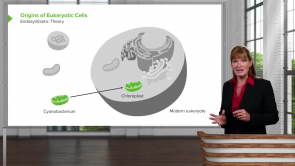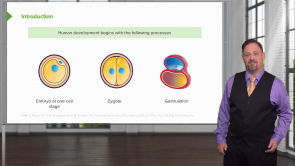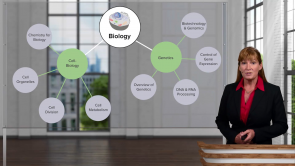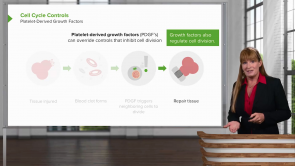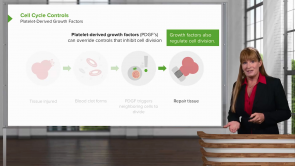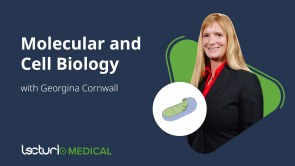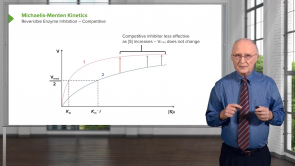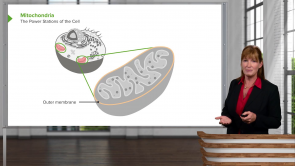Receptor Tyrosine Kinase Pathways – Second Messenger Systems

About the Lecture
The lecture Receptor Tyrosine Kinase Pathways – Second Messenger Systems by Georgina Cornwall, PhD is from the course Cellular Structure.
Included Quiz Questions
Which of the following is involved in the receptor tyrosine kinase (RTK) cascade? Select all that apply.
- Dimerization of two protein kinase receptor subunits
- Autophosphorylation
- Docking proteins and adapter proteins
- G-protein kinases
- Dephosphorylation of the dimerized protein kinase subunits
Which of the following is NOT true regarding the RTK system?
- Insulin binding to the insulin-related RTK system leads to the immediate separation of two RTK subunits to stop the propagation of the signal cascade.
- RTKs are membrane-embedded kinase proteins that play an important role in general cell functions such as cell cycle, growth, migration, and metabolism.
- Maintenance of blood glucose levels by insulin involves the RTK pathway.
- Binding of a ligand to the extracellular receptor domains causes autophosphorylation of the intracellular domains at the serine, threonine, and tyrosine residues.
- RTKs are composed of two RTK monomer units, each with a single hydrophobic α-helical transmembrane domain, which dimerize upon binding of the ligand to the receptor sites.
Which of the following results from activation of the insulin RTK signaling pathway?
- Phosphorylation of proteins in the signaling cascade will upregulate the transcription factors that increase the production of glycogen synthase.
- Denaturation of proteins will increase the destruction of GLUT channels, preventing the entry of glucose into cells.
- Synthesis of docking sites on RTKs that downregulates transcription factors for glycogen synthase
- Dephosphorylation of proteins that cleave molecules of glucose from glycogen, increasing blood glucose levels
- Upregulation of cortisol receptors
Which of the following statements best describes scaffold proteins?
- They are involved in the organization of the signaling cascade proteins/components into a highly ordered macromolecular complex for efficient signal transduction.
- They are active enzymatic components of the signaling cascade.
- They are involved in the transfer of phosphate groups from kinases and phosphatases to substrate proteins to switch them "on" or "off."
- They directly deal with the reception of an external signal to stimulate cellular responses.
- They act as molecular switches.
Which of the following is INCORRECT about molecular switches?
- Molecular switches link intracellular signals to external transduction pathways.
- Ras acts as a connecting link between receptor tyrosine kinase and mitogen-activated protein kinase.
- Ras proteins are activated and deactivated by guanine nucleotide exchange factors and GTPase activating proteins, respectively.
- The Ras system regulates the cell cycle and cell division by activating the mitogen-activated protein kinase cascade.
- The breakdown of intramolecular switches may lead to cancers due to deregulated cell-cycle and cell-division events.
Which of the following best describes adaptor proteins?
- Adaptor proteins facilitate downstream signaling events but do not participate in signal transduction.
- Adaptor proteins help other proteins dock on phosphotyrosines so that they can be phosphorylated.
- Adaptor proteins organize the kinase cascade for ultimate efficiency.
- Adaptor proteins dimerize after a ligand binds to their extracellular membrane receptor.
- Adaptor proteins activate guanylate cyclase after a ligand binds to their extracellular membrane receptor.
These courses may be of interest to you
Customer reviews
3,3 of 5 stars
| 5 Stars |
|
2 |
| 4 Stars |
|
0 |
| 3 Stars |
|
0 |
| 2 Stars |
|
1 |
| 1 Star |
|
1 |
Hi, good day to everyone. I really wanted to make a review for this lecture, because for me it was a great brief and concise explanation. Thank you very much for the easygoing explanation Dr. Cornwall. I have a bachelor in cellular and molecular biochemistry from a US college and never seen anybody explain and organize all this material in a best possible simple way. English is my second language, and I had to study this topic both in English and in my original language, in collage, so I could be able to fully understand how they worked. This type of receptors and cascades involved, are a challenge to explain how they work in a very simple way; while you either try to understand by readding it on a textbook or see it on a picture, Dr. Cornwall does a really good job on how overall it works. To all my fellows studying this lecture, I just wanted to encorage you to remember that she is mainly explaining the overall function of the receptors, the enzymes and proteins involved, don't jump just yet to understanding all the types of pathways that go through the cascade. A quick tip for everyone to understand better this topic with this video: you could try to use both video and script at the same time, pause or rewind if you didn't capture what Dr Cornwall said, and re-read the script, review the slides with the images and write as you understand, that will make engage your brain and fully understand the topic as you go. Thank you again for your explanation Dr. Cornwall; thank you very much everyone for reading me and have a good study session. You all got this!
I dont know if its the diagram or what the doctor is saying but i just cant understand the MAP kinase and the GEF and everything else afterwards
complicated topic but I think I got it, though the Tyrosine kinase itself is a bit complex
Very disorganised way of explaining concepts It would be much better if things were presented in more detail and if the presentations were structured adequately

